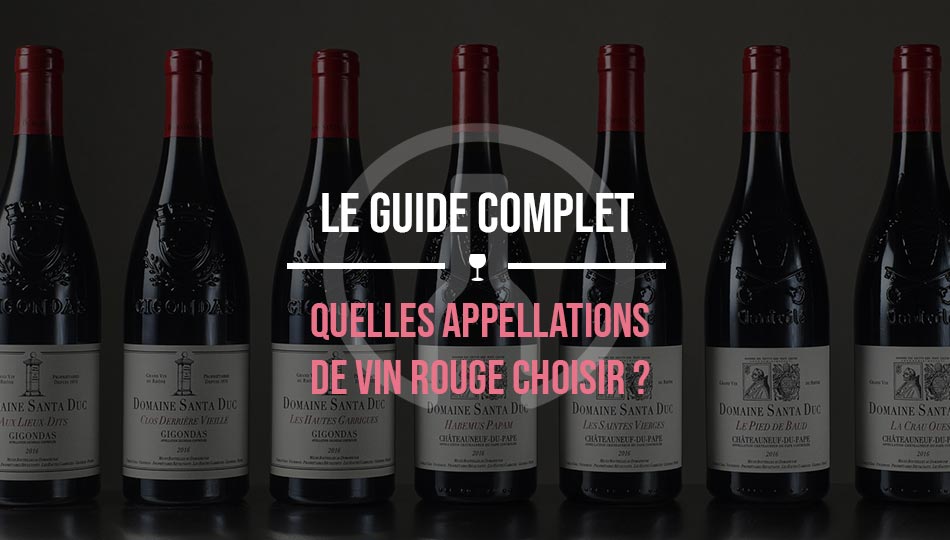Today, on Comptoir des Millésimes, your e-caviste for rare winesyou'll find our guide to the best way to buy a great red wine. Which red appellation to choose? That's the first question we'll answer. France has a great diversity of soils, climates and grape varieties. grape varieties. This makes it THE benchmark country in the wine world. Each region has its own terroir, and its own styles of wine. Of course, there's the winemaker's touch that comes into play and contributes his or her own style. Some will seek minerality and finesse, others fruit, but all will benefit from and respect the land and grape varieties they work.
Which appellation should I choose for the style of red wine I like?
Below you will find various wine styles to which we have attached appellations. This is a general description, which may change depending on the winemaker's approach.
THE "LIGHT RED WINES" STYLE:
Located in the Loire wine region, Saumur-Champigny wines are generally fruity and round. The Cabernet Franc grape is king, bringing its soft, red fruit aromas. Some winemakers age their wines in barrels, which adds a little character to the wine.
Whether in Burgundy or Alsace, Pinot Noir is a crisp, delicious grape variety. In Burgundy, on flat terroirs, Pinot expresses its morello cherry fruit, freshness and lightness. The same is true of Alsace, where Pinot Noir expresses lightness and finesse.
FRUITY, ROUND RED WINE
Saint-Émilion wines are generally made from Merlot, blended with Cabernet-Sauvignon and/or Cabernet Franc. Merlot is a grape variety that gives a lot of suppleness, fruitiness and roundness.
After a few years, Saint-Émilion wines become rounder, with notes of black fruit, spices and, in some cases, a touch of oak.
Here, we're talking about Côtes-du-Rhône and Côtes-du-Rhône-Villages, the latter being a little more powerful. The wines are warm, very fruity and, in some cases, richer and a little stewed. A wide range of grape varieties can be used to make these wines, so you'll need to taste several to get an overall impression of the appellation.
POWERFUL RED WINE
We're still in the Rhône Valley, but this time in the South. The appellation covers 3,200 hectares and was at the very beginning of the creation of the Appellations d'Origine Contrôlée. The multitude of grape varieties makes the appellation a niche for discovery, allowing you to rediscover wines again and again. Try two different Châteauneuf-du-Pape wines at the same time. Apart from aromatic power and amplitude, the wines will be completely different.
An emblematic Burgundy appellation, it lies in the Côtes de Nuits, not far from Morey-Saint-Denis and Chambolle-Musigny. Pinot Noir is the appellation's only grape variety. The wines are often barrel-aged to add body, and the tannins are sufficient to balance the density of the Pinot Noir.
The wines are rich, full-bodied and silky on the palate. Gevrey-Chambertin wines with at least 5-6 years of ageing should be tasted for their aromas of red berries and forest fruits, with a slight evolution towards undergrowth.
Find out more about the latest Gevrey Chambertin vintages on our website: 2016, 2017 and 2018.
SPICY RED WINE
Spices mean Côtes-du-Rhône or Languedoc.
Syrah is perfect for this, with its aromas of pepper and sweet spices. Côte-Rôtie is the northernmost appellation, just above Condrieu. The clay soils give Syrah remarkable substance, complexity and minerality.
We're going to talk in general terms here, as there are many differences depending on geographical location and the grape varieties used to make the wine. But whether you take a Saint-Chinian, a Faugère or a Languedoc, you're bound to find notes of spice. Whether sweet, peppery or black, the spices will be present and accompanied, depending on the appellation, by fruit, sometimes red, sometimes candied, but always warm.





![✨ Comptoir des Millésimes honors Champagne's great winemakers ✨[LINK TO THE ORGANIC CELLAR]We've selected 11 exceptional estates that reveal the full richness of Champagne terroir through unique, refined cuvées. Hugues Godmé - In Verzenay, this family-run biodynamic estate offers precise, vibrant champagnes with a beautiful mineral tension.Egly-Ouriet - A benchmark for the Montagne de Reims, its powerful champagnes, aged for long periods in barrel, impress with their complexity.Moussé Fils - In Cuisles, the Meunier grape is king. Pertois-Moriset - Pure, taut Chardonnay Grands Crus for lovers of chalky finesse. A fine address in Mesnil-sur-Oger.Geoffroy - In Aÿ, this domaine produces fine champagnes, carefully crafted and barrel-aged to reveal the full complexity of the terroir.Larmandier-Bernier - Biodynamic viticulture, exceptional parcels and purity. Crystal-clear, intense champagnes for connoisseurs.Roger Coulon - Eight generations of expertise at Vrigny. Balanced, subtle and elegant champagnes.A. Bergère - In Avize, a dynamic house offering expressive, fruity and accessible cuvées.Adrien Renoir - A promising talent from Verzy, he produces fine, complex champagnes with a true sense of terroir.De Sousa - Emblematic house in Avize. Richness, depth, long ageing: Chardonnay at its peak.Pierre Paillard - In Bouzy, the family magnifies Pinot Noir with vinous, racy and sincere cuvées.📦 Order now on our website#ComptoirdesMillésimes #Champagne #VigneronsIndépendants #GrandVin #ChampagnesdeTerroir #LivraisonRapide](https://www.comptoirdesmillesimes.com/blog/wp-content/plugins/instagram-feed/img/placeholder.png)